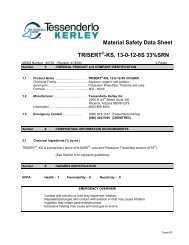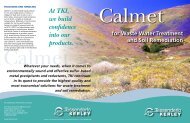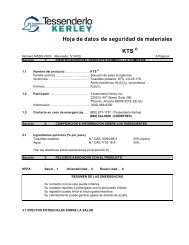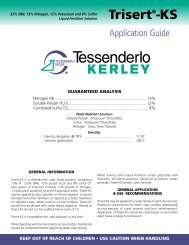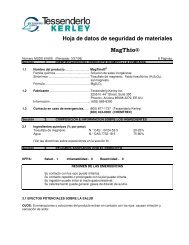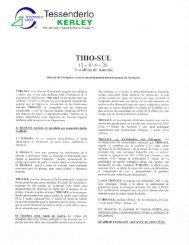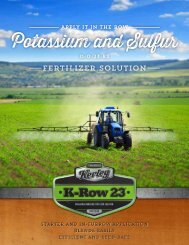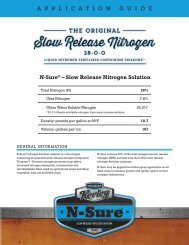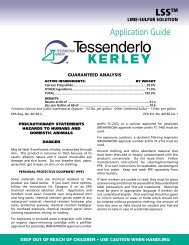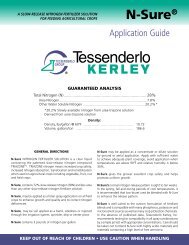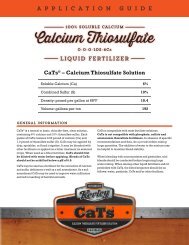trisert®-cb msds - Tessenderlo Kerley
trisert®-cb msds - Tessenderlo Kerley
trisert®-cb msds - Tessenderlo Kerley
You also want an ePaper? Increase the reach of your titles
YUMPU automatically turns print PDFs into web optimized ePapers that Google loves.
Section 3: HAZARDS IDENTIFICATION (Cont.)3.1 POTENTIAL HEALTH EFFECTSEYE: Contact with the eyes by product mist or solution may cause irritation or a burning sensation.SKIN CONTACT: Prolonged or repeated contact with product mist or solution may cause skin irritation.SKIN ABSORPTION: Absorption is unlikely to occur.INGESTION: Ingestion of product solution may cause irritation of the gastrointestinal tract to includenausea, vomiting and diarrhea. These blends are considered to have a low toxicity to humans.INHALATION: Inhalation of product mist may cause irritation of the nose, throat and respiratory tract.CHRONIC EFFECTS/CARCINOGENICITY:Not listed as a carcinogen by NTP, IARC or OSHA.Section 4: FIRST AID MEASURES4.1 EYES: Immediately flush with large quantities of water for 15 minutes. Hold eyelids apart duringirrigation to insure thorough flushing of the entire area of the eye and lids. Obtain medical attention.4.2 SKIN: Immediately flush with large quantities of water. Remove contaminated clothing under a safetyshower. Obtain medical attention if irritation occurs.4.3 INGESTION: If victim is conscious, give 2 to 4 glasses of water and induce vomiting by touching fingerto back of throat. Obtain medical attention.4.4 INHALATION: Remove victim from contaminated atmosphere. If breathing is labored, administeroxygen. If breathing has ceased, clear airway and start mouth to mouth resuscitation. If heart has stoppedbeating, external heart massage should be applied. Obtain medical attention.Section 5: FIRE FIGHTING MEASURES5.1 FLAMMABLE PROPERTIESFLASH POINT: Not flammableMETHOD USED: NA5.2 FLAMMABLE LIMITS LFL: NA UFL: NA5.3 EXTINGUISHING MEDIA: As appropriate for combustibles involved in fire.5.4 FIRE & EXPLOSIVE HAZARDS: Heating to dryness may cause the release of ammonia and carbondioxide. The evolved ammonia, NH 3, may form flammable mixtures (16-25%) with air.Keep containers/storage vessels in fire area cooled with water spray. Intense heating (such as fireconditions) may cause the release of ammonia vapors.5.5 FIRE FIGHTING EQUIPMENT: As in any fire, wear self-contained breathing apparatus, pressuredemand, MSHA/NIOSH (approved or equivalent) and full protective gear.Trisert-CB Page| 2
Section 6: ACCIDENTAL RELEASE MEASURES6.1 Small releases: Confine and absorb small releases on sand earth or other inert absorbent. Use waterspray to dilute to weak fertilizer solution.6.2 Large releases: Confine area to qualified personnel. Shut off release if safe to do so. Dike spill area toprevent runoff into sewers, drains or surface waterways (potential aquatic toxicity). Recover as much of thesolution as possible. Treat remaining material as a small release (above).Section 7: HANDLING and STORAGE7.1 Handling: Avoid contact with eyes. Use only in a well ventilated area. Wash thoroughly after handling.Avoid prolonged or repeated breathing of vapors. Avoid prolonged or repeated contact with the skin.7.2 Storage: Store in well ventilated areas. Do not store combustibles in the area of storage vessels. Keepaway from any sources of heat or flame. Store tote and smaller containers out of direct sunlight at moderatetemperatures [less than 105ºF (41ºC)]. Do not store at temperatures below 0º F as crystallization may occur.See Section 10.4 for Materials of construction)Section 8: EXPOSURE CONTROLS, PERSONAL PROTECTION8.1 RESPIRATORY PROTECTION: None generally required. If conditions exist where mist may begenerated, a NIOSH/MSHA approved mist respirator should be worn.8.2 SKIN PROTECTION: Neoprene rubber gloves and apron should be worn to prevent repeated orprolonged contact with the liquid. Wash contaminated clothing prior to reuse.8.3 EYE PROTECTION: Chemical goggles and a full face shield.8.4 EXPOSURE GUIDELINES:OSHAACGIHTWA STEL TLV STELNone N/A NA NA NA8.5 ENGINEERING CONTROLS: Use adequate exhaust ventilation to prevent inhalation of product vapors.Section 9: PHYSICAL and CHEMICAL PROPERTIES9.1 APPEARANCE: Clear, green liquid9.2 ODOR: May have a slight amine odor9.3 BOILING POINT: 230ºF (110º C)9.4 VAPOR PRESSURE: Not Determined9.5 VAPOR DENSITY: Not determined9.6 SOLUBILITY IN WATER: Complete9.7 SPECIFIC GRAVITY: 1.223 (10.2 lbs/gal)Trisert-CB Page| 3
Section 9: PHYSICAL and CHEMICAL PROPERTIES, Cont.9.8 MELTING POINT: Salt out temperature less than 0º F (-17.8ºC)9.9 pH: Typically 8.79.10 VOLATILE: Not applicableSection 10: STABILITY and REACTIVITY10.1 STABILITY: This is a stable material10.2 HAZARDOUS POLYMERIZATION: Will not occur10.3 HAZARDOUS DECOMPOSITION PRODUCTS: Heating to dryness will cause the production ofammonia, and oxides of carbon. The evolved ammonia may form flammable mixtures (16-25%) with air.10.4 INCOMPATIBILITY: Strong oxidizers such as nitrates, nitrites or chlorates can cause explosivemixtures if heated to dryness. Avoid contact with Acids or acid materials. This product may not becompatible with copper, zinc or their alloys (i.e. bronze, brass, galvanized metals, etc.). These materials ofconstruction should not be used in piping, handling systems or storage containers for this product. (SEESection 7.2, Storage)Section 11: TOXICOLOGICAL INFORMATION11.1 ORAL: Data not available11.2 DERMAL: Data not available11.3 INHALATION: Data not available11.4 CHRONIC/CARCINOGENICITY: No evidence available11.5 TERATOLOGY: Data not available11.6 REPRODUCTION: Data not available11.7 MUTAGENICITY: Data not availableSection 12: ECOLOGICAL INFORMATIONNo data available.Section 13: DISPOSAL CONSIDERATIONSThe product TRISERT®-CB is not considered hazardous waste under Federal Hazardous WasteRegulations, 40 CFR 261. Consult state and local regulations for more restrictive disposal regulations.Trisert-CB Page| 4
Section 14: TRANSPORT INFORMATIONTrisert ® -CB is classified as non-hazardous by all means of shipping, both domestically and internationally14.1 DOT Requirements14.1.1 Shipping Name: Triazone, urea, & disodium octa-borate solution14.1.2 Hazard Class: NA14.1.3 UN/NA Number: NA14.1.4 Packing Group: NA14.1.5 DOT Placard: NA14.1.6 DOT Label(s): NA14.2 Other DOT Requirements14.2.1 Reportable Quantity (RQ): No14.2.2 Emergency Response Guide: NA14.2.3 RR STCC Code: Unknown14.3 International Transportation14.3.1 IMO: Non-hazardous under IMO regulations14.3.1.1 Shipping Name: Triazone, urea, ammonium sulfate and disodium octa-boratefertilizer solution14.3.2 IATA: Non-hazardous under IATA regulations14.3.2.1 Shipping Name: Triazone, urea, ammonium sulfate and disodium octa-boratefertilizer solutionSection 15: REGULATORY INFORMATION15.1 OSHA: This product is considered a hazardous material under criteria of theFederal OSHA Hazard Communication Standard, 29 CFR 1910.1200.15.2 SARA TITLE III: a. EHS (Extremely Hazardous Substance) List: Nob. Section 311/312, (Tier I,II) Categories: Immediate (acute) YesFireNoSudden release NoReactivityNoDelayed (chronic) Noc. Section 313 (Toxic Release Reporting-Form R): YesChemical Name CAS Number ConcentrationAmmonia 7446-41-7 0.26%d. TPQ (Threshold Planning Quantity): NoTrisert-CB Page| 5
Section 15: REGULATORY INFORMATION (Cont.)15.3 CERCLA/SUPERFUND: RQ (Reportable Quantity) No15.4 TSCA (Toxic Substance Control Act) Inventory List: Yes15.5 RCRA (Resource Conservation and Recovery Act) Status: NA15.6 WHMIS (Canada) Hazard Classification: NA15.7 DOT Hazardous Material: (See Section 14) No15.8 CAA Hazardous Air Pollutant (HAP) NoSection 16: OTHER INFORMATIONTRISERT® is a registered trademark of <strong>Tessenderlo</strong> <strong>Kerley</strong>, Inc., Phoenix, ArizonaREVISIONS:The entire MSDS was reformatted to comply to ANSI Standard Z400.1-1993, by Technical Services-<strong>Tessenderlo</strong> <strong>Kerley</strong>, Inc.Address updated 4/30/99Revised OSHA rating, Section 15.1, 10/12/2001Revised Section 8.3, eye Protection, and company logo, 5/6/02Revised Section 14, transportation, 12/3/2010Section 2.1, and MSDS Number, 12/7/2011.THE INFORMATION PUBLISHED IN THIS MATERIAL SAFETY DATA SHEET HAS BEEN COMPILED FROM OUR EXPERIENCE ANDOSHA, ANSI, NFPA, DOT, ERG, AND CHRIS. IT IS THE USER’S RESPONSIBILITY TO DETERMINE THE SUITABILITY OF THISINFORMATION FOR THE ADOPTION OF NECESSARY SAFETY PRECAUTIONS. WE RESERVE THE RIGHT TO REVISE MATERIALSAFETY DATA SHEETS PERIODICALLY AS NEW INFORMATION BECOMES AVAILABLE.Trisert-CB Page| 6



